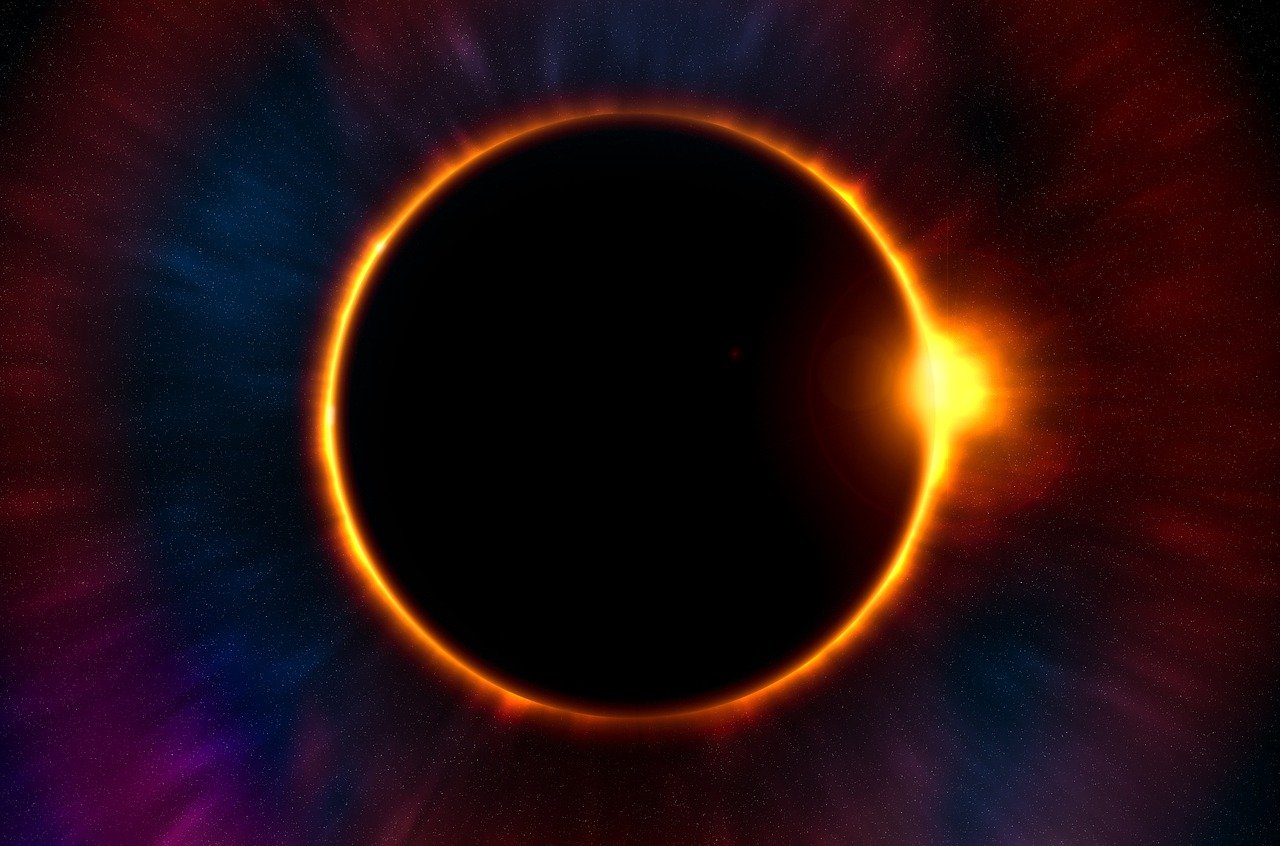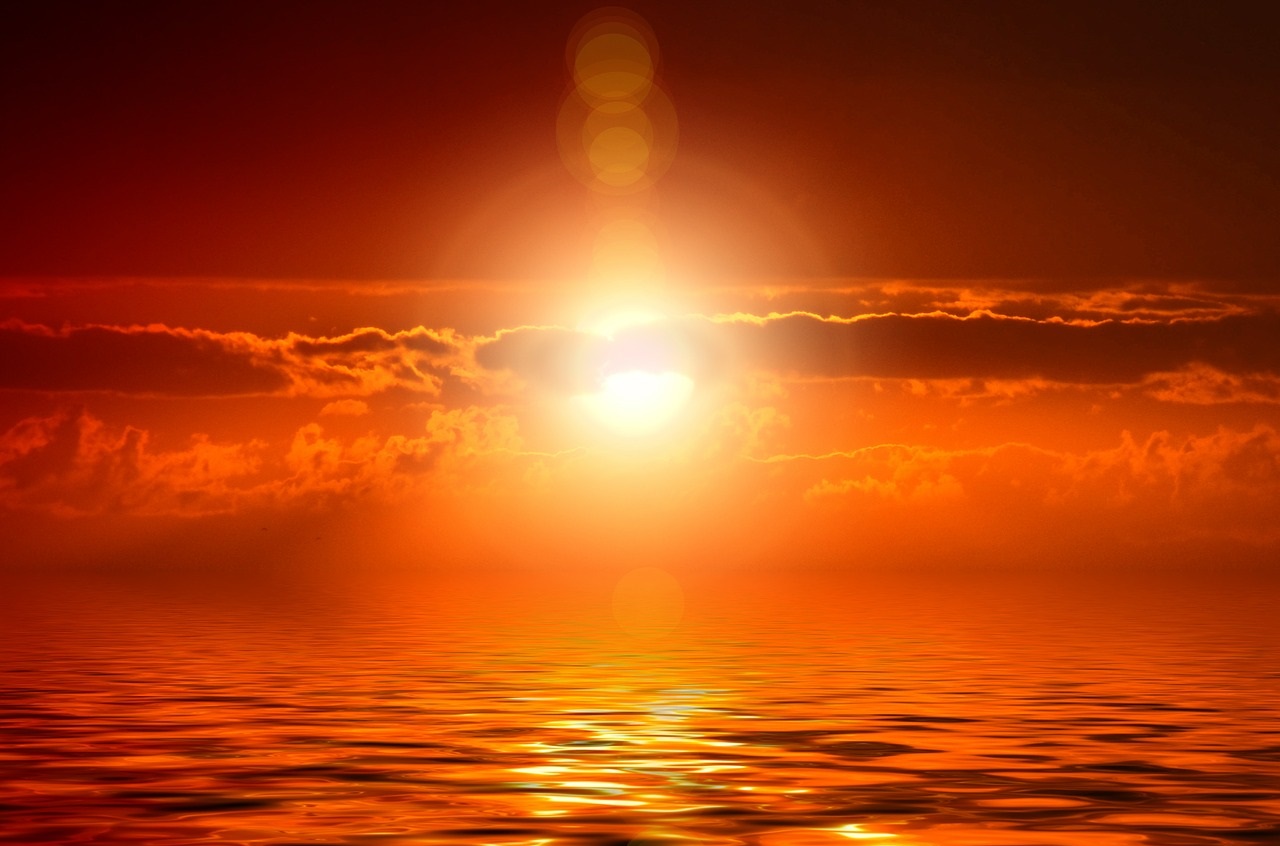Stardust and eternity – 3.1.5
The Sun
The Sun is the nearest star, as well as the center around which the Earth and other planets of the Solar System revolve around. It has a radius of 700,000 km – about 110 the radius of our planet – and it is 333,000 times heavier than the Earth. Temperature on the Sun is so hot that most of the gas composing its structure – mostly hydrogen (73%) and helium (25%) – lays in a state of plasma, similarly to most other stars. An outstanding temperature of 15 million °C is reached in the Sun’s core, allowing nuclear reactions to occur – thus fueling our star. More specifically, the Sun’s energy is mostly produced through a process called “nuclear fusion” – lightest hydrogen atoms combine into heavier helium atoms, that releases about 0.7% of their mass into energy in the form of powerful gamma rays according to the well-known Einstein’s formula E=mc2. This energy source alone has enabled the Sun to exist for up to 4.6 billion years and is expected to fuel it for at least a similar amount of time. The gamma rays emitted through this process are continuously absorbed and reflected back in all directions by the hot plasma environment. During their travel towards the Sun’s surface – which takes about 170,000 years – they keep loosing energy. Finally, they are able to escape the Sun and reach us in the form of a broad range of electromagnetic radiation, the most intense of which occurs in the visible portion of the spectrum as “optical light”.
The visible spherical surface of the Sun, where light can finally escape through space, is traditionally called “photosphere” – from the Greek photos, meaning “light”. This thin layer of the Sun is just a few km long and has a temperature of about 5,500°C; this implies a rapid decrease in temperature from the core – where nuclear reactions occur – to the surface of the Sun, where finally the energy produced is emitted into space. Quite mysteriously, however, just above the photosphere, the temperature of the solar atmosphere rises again up to millions of degrees in a region called corona – from the Latin word for “crown”. It extends for several millions km above the Sun’s surface. Plasma in the corona is extremely rarified and consists of atoms that have been highly ionized; it means they have been stripped of their electrons orbiting around the nucleus by the tremendous heat of this region. The corona is regularly observed with specifically designed telescopes called “coronagraphs”. Coronagraphs occult the disk of the Sun; however, it can be easily visible by eye on specific occasions, thanks to stunning solar eclipses.
Other fascinating visible features of the Sun are the so-called “sunspots” – regions of the solar surface that look dark because they are cooler than the surrounding photosphere. Actually, this phenomenon is due to an optical illusion deriving from the contrast in temperatures! Indeed, the strong magnetic fields found in sunspots – whose size may easily exceed that of the Earth – are so strong that they push away the hot plasma, thus cooling it some 1000°C less than average. Although the earliest records of sunspots date back to ancient Chinese and Greek civilizations, they have been regularly observed only since the XVII century, with the invention of telescopes. This has allowed to infer the presence of a “solar cycle”: during its maximum active phase: the photosphere becomes temporarily stained by several sunspots while, after about 11 years, sunspots disappear from sight. The discovery of this cycle has allowed scientists to conjecture the presence of an internal “solar dynamo” that periodically generates the Sun’s magnetic field, emerging only on specific “sunspot” locations.
During its maximum phase of activity, the Sun is particularly subject to sudden releases of electromagnetic radiation – “solar flares” – and of billion-ton plasma blobs – “coronal mass ejections”, which are able to sweep out into the Solar System and reach the Earth, thus provoking possible damages to orbiting satellites or exposing astronauts to harmful radiation. Fortunately enough, the “magnetosphere” of the Earth – i.e. the cocoon-shaped magnetic region generated by the Earth’s molten iron core – shields most of the electrically charged energetic particles emitted by the Sun. On a positive note, some of these particles are deemed to rain down on the Northern and Southern poles, colliding with the atmosphere and producing in the polar skies, at specific high latitudes, beautifully colored “auroras”.
Further resources
Links below will redirect you to external websites. In accordance with the European data protection declarations, we would like to point out that by clicking on these links you may send data to external providers. We cannot prevent that.
Images
![]() Spectrum of a Fluorescent Light Bulb vs. Spectrum of the Sun (NASA, ESA, Leah Hustak – STScI)
Spectrum of a Fluorescent Light Bulb vs. Spectrum of the Sun (NASA, ESA, Leah Hustak – STScI)
![]() The Sun (NASA/Goddard)
The Sun (NASA/Goddard)
![]() Massive Filament Eruption, with Superimposed Earth Scale (NASA/SDO/AIA)
Massive Filament Eruption, with Superimposed Earth Scale (NASA/SDO/AIA)
![]() Gigantic Rolling Wave Captured on the Sun (NASA/Goddard)
Gigantic Rolling Wave Captured on the Sun (NASA/Goddard)
![]() Internal compression of the Sun (Kenneth R. Lang, Tufts University)
Internal compression of the Sun (Kenneth R. Lang, Tufts University)
![]() Internal composition of the Sun (Kenneth R. Lang, Tufts University)
Internal composition of the Sun (Kenneth R. Lang, Tufts University)
![]() The total solar eclipse of 21 August 2017 (ESO/P. Horálek/Solar Wind Sherpas project)
The total solar eclipse of 21 August 2017 (ESO/P. Horálek/Solar Wind Sherpas project)
![]() Sunspots (Michael Teoh, Heng Ee Observatory, Penang, Malaysia)
Sunspots (Michael Teoh, Heng Ee Observatory, Penang, Malaysia)
![]() A Complete Solar Cycle from SOHO (SOHO – EIT Consortium, ESA, NASA)
A Complete Solar Cycle from SOHO (SOHO – EIT Consortium, ESA, NASA)
Videos
![]() Sun 101 (National Geographic)
Sun 101 (National Geographic)
![]() The Sun (Crash course astronomy)
The Sun (Crash course astronomy)
![]() The Sun – Documentary (BBC)
The Sun – Documentary (BBC)
![]() Discovering the secrets of the Sun (SPACETIME – SCIENCE SHOW)
Discovering the secrets of the Sun (SPACETIME – SCIENCE SHOW)
Online resources
![]() Our Sun (NASA Science)
Our Sun (NASA Science)
![]() Sun (National Geographic Science)
Sun (National Geographic Science)
![]() Earth’s sun: Facts about the sun’s age, size and history (Space.com)
Earth’s sun: Facts about the sun’s age, size and history (Space.com)
Further readings
![]() 15 Million Degrees: A Journey to the Centre of the Sun (Lucie Green)
15 Million Degrees: A Journey to the Centre of the Sun (Lucie Green)
![]() The Sun: A Biography (David Whitehouse)
The Sun: A Biography (David Whitehouse)
![]() New Eyes on the Sun: A Guide to Satellite Images and Amateur Observation (John Wilkinson)
New Eyes on the Sun: A Guide to Satellite Images and Amateur Observation (John Wilkinson)
![]() How to Observe the Sun Safely (Lee Macdonald)
How to Observe the Sun Safely (Lee Macdonald)
Teaching Material
![]() Sun as a star: science learning activities for afterschool (NASA)
Sun as a star: science learning activities for afterschool (NASA)
For Kids
![]() What is the Sun? (video)
What is the Sun? (video)
![]() Here comes the Sun (video)
Here comes the Sun (video)
![]() Seasons and the Sun (video)
Seasons and the Sun (video)
![]() All About the Sun for Kids (video)
All About the Sun for Kids (video)
![]() All About the Sun (NASA)
All About the Sun (NASA)


